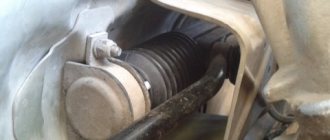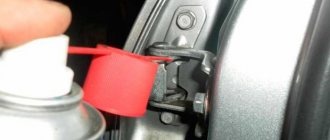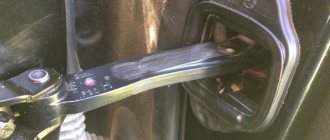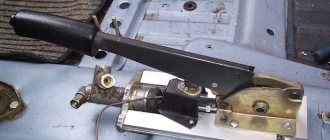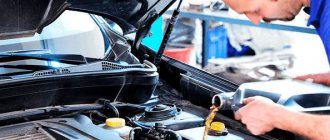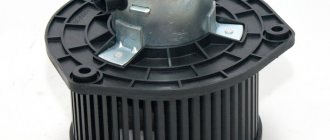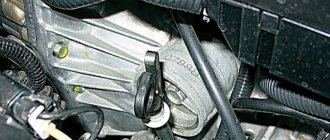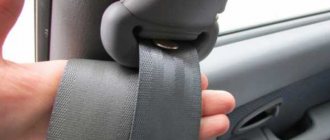Any vehicle needs periodic maintenance. The rule applies to all components, systems and important parts. Ignoring it will lead to technical malfunctions. Not only the engine, but also less significant elements require attention. These include door locks and hinges. Without proper care, they will begin to creak and have problems opening. If you ignore the problem for several months. These elements will be subject to increased wear due to rust. In winter, an unlucky driver will be faced with the fact that the door will not open. This kind of difficulty can be avoided if you regularly use lubricant.
Why are locks and hinges lubricated?
Over time, the lubricant used at the factory loses its effectiveness. Many people think about such manipulations after a squeak appears. It is not right. It is recommended to lubricate the hinges and lock before specific problems appear. Prevention eliminates unpleasant sounds and promotes easy and smooth movement.
Those who fix the problem after it occurs should initially familiarize themselves with the condition of the sealing rubber bands and hinges. The tightness of the fit of the door to the body depends on the rubber bands. If problems are detected, you need to think about replacing them. Damage (cracks, severe rust, deformation of fastenings and other elements) signals the advisability of repair and restoration work or a complete replacement.
Car doors are subject to more stress than the front doors of a home. Especially on the driver's side. Since it is used most often during active driving. But there are times when the squeaking occurs on the passenger side.
Problems arise from operation in a complex, aggressive environment. The lubricant is produced, loses its properties, and attracts dirt.
The castle is subject to similar influences. One body is not enough. High humidity causes corrosion. Dust and dirt particles penetrate into the mechanism through the keyhole. They come in with a draft or on the key. By settling on the mechanism, they increase friction between the elements. Normal operation is possible when the parts slide smoothly. Foreign particles become clogged between the moving components of the lock. Turning the key becomes more difficult. In certain cases it may break.
Preventative work is most relevant before the arrival of winter. Without proper protection, the lock will freeze. Water, penetrating inside the rotating mechanism, freezes and binds it. Rotation is not possible.
The main causes of unpleasant sound
- Poor quality factory assembly and unregulated balance.
- High level of pollution. The deposition of dust and dirt leads to a decrease and complete loss of the consumer properties of the lubricant.
- High pressure washer. Fast and effective cleaning is accompanied by the complete removal of any type of lubricant on the parts.
- Adverse weather conditions (low temperatures, high humidity, temperature fluctuations, aggressive chemicals for road treatment, etc.).
- Wear of rubber seals. A loose fit of the door to the body will lead to moisture leakage, condensation in the interior and other negative phenomena that will negatively affect the performance of the lock.
- Active use of doors.
What to do if the car door lock is frozen?
Freezing of the lock in cold weather is a normal phenomenon and a common situation among those who did not take care to lubricate the door keyhole in advance.
Often the door lock freezes after washing. Moisture that gets into the locking mechanism freezes. As a result, there is a problem with opening the car door.
There are two ways out of this situation:
- Use a lock defroster. You can purchase it at any auto parts store. Just don't store it in the trunk; the trunk door lock may also freeze.
- If you smoke, then a lighter will come to the rescue, because... with its help you can warm up the key and insert it into the lock, thus melting the ice. But here you need to be extremely careful, if the key has a chip built into it, you can ruin it. If you warm up the key, then only a spare one and without a built-in chip.
How not to open a frozen lock:
- Never heat the lock with fire, the handles are made of plastic, you will only make things worse.
- Do not pour boiling water on the castle; in frosty conditions your situation will worsen, and the water will freeze eventually anyway. In addition, the paint and varnish of the car will be damaged due to sudden temperature changes.
The door is frozen, what to do
Often the rubber door seals freeze, and even if the lock is working, the door cannot be opened. A defrost will be an assistant in such a situation.
After this, be sure to treat the seals with silicone grease, this will protect you from freezing of the door to the car body.
About lubrication
Previously, the driver had to resort to tricks to eliminate squeaks. Available materials were used (kerosene, vinegar-based acid and even iodine), including an oil press. These times have passed with the advent of auto chemistry. Thanks to its high efficiency, it won the trust of consumers and gradually replaced improvised means from everyday use. Chemistry has made car maintenance much easier. Another significant advantage is that it will not be difficult to purchase it at the nearest specialized point.
A lubricant is a substance of a certain consistency used to treat friction pairs and create a film for smooth operation. Additives and additional components are added to the base to give the product the necessary qualities.
Main components:
- additives;
- thickeners;
- lubricating oils.
Depending on the composition, the lubricant is:
- liquid;
- semi-hard (plastic);
- hard.
What should the lubricant be?
The substance provides protection for doors and hinges in extreme conditions, including low temperatures. To work without any problems, it must meet a number of specific requirements.
- Strength. The characteristics determine whether the composition will adhere to surfaces subject to friction. Considering the characteristics of operation, it should be high, but at the same time remain flexible. Otherwise, the composition will not get into the places of contact of interacting elements.
- Viscosity. Characterizes the behavior during flow and affects the rate of deformation. A rapid change in state leads to a decrease in viscosity. Engine oils behave differently; their thickness remains unchanged at certain temperatures.
- Heat resistance. Some compositions, depending on temperature, can transform from solid to liquid. Other lubricants at lower rates break down into their components: oil and thickener. As a result of chemical influences, they can heat up, cool down, oxidize and evaporate. Such manipulations increase strength but minimize lubricating qualities.
- Frost resistance. Affects the restoration of the frame and fluidity (does not harden) under the influence of low temperatures. A significant decrease will lead to loss of mobility of parts and delamination. The grease will not reach the required location.
- Thixotropy. Preservation of volumetric and mechanical properties after active deformation. Intense impact leads to loss of strength for some time. Then it goes up. As a rule, the maximum values are lower than the original ones, but over time they can recover. The use of unstable lubricants will lead to problems.
- Physico-chemical stability.
- Moisture resistance. The lubricant does not allow water to pass to the surfaces being treated.
- Adhesion. One of the main characteristics that determines efficiency. It determines how strongly the material sticks to the surface. High-quality lubricant is difficult to remove from the elements being processed.
- Anti-seize. Affects the protection of the part from jamming and scuffing under minor mechanical loads.
- Anti-wear. Reduces negative consequences during friction. Not every lubricant with high wear resistance is effective against scuffing. This is due to the fact that anti-wear properties depend on the dispersed medium, while extreme pressure properties depend on the composition (additives).
- Anti-corrosion. Effective protection against negative environmental influences and extreme conditions.
Dashboard
This is the most problematic area of most used cars. To understand where exactly the “play” is, you need to try pressing the plastic panels one by one while driving and listen to see if the sound has disappeared (therefore, it is better if there is an assistant in the car). You can also try to insert an unnecessary plastic card into the cracks that cause the most suspicion. If the grinding noise has disappeared, then the “cricket” has been found. All that's left is to get rid of him.
Healthy! To determine exactly at which joint the unpleasant sound occurs, it is enough to inspect the surfaces. As a rule, abrasions appear in such places.
There are two options for how to do this - simpler and more complicated:
- We completely dismantle the dashboard and put Modelin (one sheet of sound insulation will cost 760 rubles), Bitoplast (a sheet will cost 250 rubles) or so-called mushrooms (plates with small “outgrowths” that make the joints even tighter) into the joints. Particular attention should be paid to the panel's hinged elements (glove box lid, fuse box, clock, etc.).
We recommend: Why and how often to refill your air conditioner. How risky is it to do such a procedure yourself?
Healthy! Some people glue the joints with special tape or regular adhesive tape from the pharmacy.
- Pour silicone grease into the cracks (a can of WD-40 with a spout will cost about 250 rubles) and wipe off the excess with a napkin.
Silicone grease is the fastest and cheaper option. But you shouldn’t expect it to work for a long time, so the procedure will have to be repeated periodically. Fortunately, this composition is not conductive, so you don’t have to worry about “shorting” the dashboard.
Healthy! If the dashboard of a car consists of many parts (such as in the Chevrolet Lacetti), which are attached with self-tapping screws, then one disassembly is enough for extraneous sounds to begin to appear in the car. If this element is a monolith (as in Renault Logan), then even a used car will not have problems with “crickets” in this area.
What are they?
- Carbon (graphite). It consists of mineral oil with additives of the same substance and a thickener (calcium soap). The oil base imparts water-repellent properties. The resulting mass is dark brown or black. Suitable for use at temperatures from -20 to +70° C. Experts recommend using it when the lock has already begun to jam slightly and there are problems with turning the key. Significantly extends the life of the mechanism and protects against corrosion. Mainly used to preserve a car for a long time. One of the main advantages is the affordable price. Distributed in the form of aerosols.
- Lithium. Molybdenum disulfide and lithium are used as a base. Salt has proven itself well in care products for engines, bearings, transmissions and CV joints. Lithium minimizes friction between parts and displaces moisture. The substance prevents the start of oxidation processes and the formation of rust on metal surfaces, and is also resistant to aggressive chemicals. Among the shortcomings, it should be noted the loss of a number of useful qualities when large amounts of dust enter. On the shelves, lithium grease is presented as an aerosol (cans).
- Mineral (consistent). A time-tested product that shows impressive results. They reveal themselves well in winter, since at this time the parts are most exposed to moisture in the form of condensation. The substance has a high penetrating ability, allowing it to penetrate any keyhole without additional effort. Forms a protective film that is resistant to abrasion and washing off. Retains its qualities over a wide temperature range.
- Polymer (silicone). Modern popular solution. The base is silicone. The substance is compatible with metal, plastic and rubber. The composition is produced by all well-known companies. The resulting film remains on the surface for 2 seasons, with careful use. For active driving, treatment is recommended 2 times a season. Works in a wide temperature range. Can be used even at -50°C. High adhesive properties reduce the time of film formation after application of the substance. The layer can withstand light pressure washing. Distributed in compact cans, sprays and tubes. The paste-like consistency is rubbed in with your hands, carefully working every curve. Manipulations are carried out in protective equipment.
How to choose?
Regardless of the manufacturer, the lubricant must meet a number of requirements:
- high viscosity;
- anti-corrosion resistance;
- lubricating qualities at a high level;
- moisture resistance;
- resistance to aggressive chemicals;
- film resistant to physical impact;
- maintaining characteristics at low and high temperatures.
Only in this case the processed elements will remain safe. To maintain the required level of protection, the film must be renewed periodically.
About WD-40
A popular product, the use of which is actively promoted by many motorists. According to them, the spray can be used to lubricate locks. The action of the product can be compared to kerosene. After cleaning the part from the old lubricant, it evaporates.
The main tasks performed by WD-40:
- displacement and removal of moisture;
- rust removal.
The spray does not protect the part from wear and friction. Regular use as a lubricant will result in the need to replace the lock. Lubricating qualities produce a short-term effect.
WD-40 is indispensable in an emergency situation (it is impossible to open a frozen locking device, or parts are stuck). But after exposure, it is necessary to use a lubricant with stable properties in the near future. Otherwise, the operation of the mechanism will deteriorate.
Additional means to lubricate the lock
The lubricants described above relate to modern developments and results of the chemical industry. However, before their appearance, drivers for decades used various improvised means to lubricate locks and door hinges. For example, kerosene, acetic acid and even iodine. Let’s present for you a couple more, so to speak, “folk” remedies that you can use to lubricate car door locks for the winter. After all, it is during the cold season that locks create additional difficulties in order to get inside or close the door. And the question of which lubricant is better to lubricate becomes more relevant.
WD-40
Processing of VAZ 2108-2109 locks
Yes, the good old WD-40 lubricant can also be used to inject into the lock cylinder, but in no case on all its rubbing mechanisms. The fact is that the main component of this product is white spirit (50% of the volume), whose freezing point is -60°C. Therefore, it washes away any remaining lubricant. The liquid is sold as an aerosol in a can with a tube, with which you can easily spray the product into hard-to-reach places.
This liquid key can be used to dehydrate the surface to which it is applied, removing corrosion from it and preventing its reappearance, forming a protective film on it. In general, the product is used very widely. And not only for processing car parts, but also in everyday life.
A significant disadvantage of treating locks with WD-40 is its short duration of action. In severe frosts, the larva must be treated with this product approximately every two days.
When treating a door lock with a “wedeshka” (both automobile and household), it is advisable to apply silicone grease to the same surfaces. You can use one of the lubricants listed above, or use any other.
Lock defroster
Various defrosters
In this case, we are talking about special products, the packaging of which says “Lock defroster” or something similar. They usually contain oil or white spirit, less often silicone. Such products are inexpensive and work well, at least in relatively mild frosts. The disadvantage of these products is their short duration of action, since their composition is similar to WD-40.
When purchasing such lubricants, carefully read the instructions. Manufacturers often attribute truly miraculous properties to their products. However, you need to understand that if the product is inexpensive (and most often it is), then you shouldn’t expect any miracles from it. Just regularly treat the lock cylinder and mechanism with “Lock Defrosters” in the winter and you won’t have any difficulties opening it. But only in the spring, after using it, it is recommended to treat the lock mechanism with a different composition. In particular, one that could protect against corrosion and friction.
Engine oil
If for some reason you don’t have any lubricant on hand (one of the above or others), then you can use regular motor oil to lubricate the car door lock both from freezing and for stable operation. Its viscosity, brand and consistency are not important in this case (well, unless it should be frankly black with soot and debris). Using a syringe or other similar devices, you should pour a few drops of oil into the cylinder and/or treat the lock mechanism. This will create a water-repellent film on the surface of its internal parts and prevent freezing.
However, the oil has the disadvantage mentioned above - its effect is short-lived and will also attract dust. Therefore, it can only be used if you do not have more professional means at your disposal. And at the first opportunity, buy any of the lubricants listed above.
The best graphite lubricants for door locks and hinges
OILRIGHT 0.25 kg
Lubricant from a domestic manufacturer. The universal product is intended for use at home and at work. Reduces friction and ensures smooth and quiet operation of mechanisms. It has a gentle effect on the surface, and is sensitive to paint, rubber and plastic.
OILRIGHT lubricant 0.25 kg
Advantages:
- antifriction;
- anti-scuff;
- works in a wide temperature range;
- universal;
- variable volume;
- affordable price.
Flaws:
- pasty;
- strong unpleasant odor.
ELTRANS 0.4 l
Despite its cost, the product is famous for its high adhesive and lubricating qualities. Creates a film resistant to high temperatures that invariably occur in friction units. The coating retains its properties after the other components have been completely depleted.
ELTRANS lubricant 0.4 l
Advantages:
- antifriction;
- Suitable for processing electrical connections;
- comfortable application to hard-to-reach places.
Flaws:
- not suitable for areas where winter temperatures drop below 20°C;
- There will be difficulties with the straw.
Golden Snail l, 400 ml
The product obtained a high level of adhesion and electrical conductivity. Combined with increased lubricating properties and resistance to high temperatures, it is most attractive to drivers who care about their vehicle. In addition to door hinges, bearings and battery terminals can be processed. The created electrically conductive coating prevents souring and sticking. It is noteworthy that finely dispersed graphite in the friction zone retains antifriction properties after the other components have already exhausted their service life.
Golden Snail l lubricant, 400 ml
Advantages:
- efficiency;
- moisture-repellent;
- antifriction;
- works in a wide temperature range.
Flaws:
- Mostly distributed in a set of 4 pieces.
Common brands of lubricants for car doors
Among the products available on the market there are many specialized lubricants designed specifically for lubricating door hinges in cars, produced in small packaging and with a convenient sprayer. There are also many universal lubricants that can be used both for car doors and for other parts and components of the car.
Silicone Wax lubricant spray is a universal product for protecting rubber and plastic products, lubricating mechanisms and moving parts, and preventing moisture from entering electrical contacts.
Unlike most silicone lubricants, which form an oil-like coating, Suprotek Aprohim's "Wax" is a mixture of silicone liquids and resins and, when dried, forms a dense, wax-like, water-repellent film.
Best Lithium Greases for Door Locks and Hinges
VERYLUBE 320 ml
A universal consistency material developed based on the innovative Extreme Pressure formula. The product is suitable for protecting door locks, hinges and components subject to increased loads (hinges, plain and rolling bearings). A thick substance, enveloping the part, creates a coating that protects the connection from increased wear, dust, dirt and aggressive chemical compounds. Penetrates into hard-to-reach places and, due to its stickiness, remains there for a long time.
VERYLUBE lubricant 320 ml
Advantages:
- neutral to plastic, rubber, wood;
- easy application;
- sealing properties;
- prevents the start of oxidative processes;
- mechanically and chemically stable substance.
Flaws:
- not common.
AVS AVK-104 0.335 l
Unpleasant creaking of door hinges, difficult to open locks, stuck battery terminals, jammed cables - you can forget about these and many other problems with a new product from AVS. It spreads in aerosol form. This makes it easier to process mechanisms and components, since there is no need to remove and disassemble. The extension tube will make it easier for the substance to reach hard-to-reach places. The plastic structure settles tightly on the surface.
grease AVS AVK-104 0.335 l
Advantages:
- retains properties down to -40 °C;
- upper operating limit 120 °C;
- anti-corrosion;
- adhesive.
Flaws:
- the resulting effect does not last long.
Hi-Gear White lithium grease 0.312 kg
Contains a complex of additives that increase the performance characteristics of the composition. It will be appreciated by residents of cold regions, where in winter the temperature drops to -45° C. It has a gentle effect on the surface and forgives careless contact with plastic, rubber and metal. The resulting anti-corrosion coating keeps the part in its original condition for a long time.
Hi-Gear White lithium grease 0.312 kg
Advantages:
- universal;
- the film lasts for a long time;
- does not thicken in the cold;
- resistance to salts and chemicals.
Flaws:
- covers more surface than required;
- often counterfeited.
How and with what to treat rubber car door seals in winter: popular materials
Sealing elements of doorways are designed to prevent dirt and dust from entering the vehicle interior. But frosty weather makes its own adjustments, and the tires lose some of their parameters. Freezing moisture can destroy the structure of the sealing material over time, so we must not forget about its protection.
It should be noted that before treating car door seals in winter, it is important to clean them from dirt and dust, because they actively interact with moisture and glue the surfaces together. You especially need to make sure that all kinds of sweet and sticky liquids do not get on the rubber. It should be recognized that the optimal solution is to pre-treat the sealing parts with an aerosol before the onset of cold weather. Below are the most popular auto chemicals for these purposes.
High purity silicone oil Molykote Separator Spray
A unique release solution based on silicone and organosilicon materials. A wide range of operating temperatures allows the spray to be used in various industries. However, its main application is rubber and plastic elements.
The synthetic polymer polydimethylsiloxane contained in the lubricant, unlike petrochemical products, allows the material to be used in a wide temperature range. In this case, the viscosity of the mixture changes by insignificant amounts. The average price of a 400 ml cylinder is about 800 rubles.
Silicon-Fett or how to lubricate rubber seals on car doors in winter from Liqui Moly?
Good contact lubricant for areas involving rubber or plastic. The mixture protects parts from drying out and the effects of ultraviolet radiation. The main parameters can be expressed in several points:
- Resistant to cold and hot water.
- Excellent adhesion and aging resistance.
- High level of anti-friction characteristics.
The manufacturer guarantees a temperature range of use from -40 to +180°C. Before lubricating the external locks and hinges of car doors for the winter, all components of the unit must be cleaned of dust and rust. The average price of a 50 ml tube is 325 rubles.
Budget silicone lubricants from Lavr
Thanks to high-tech developments in the field of auto chemicals and auto cosmetics, a young domestic brand is quite confidently conquering the market. Silicone lubricant is available in two types of cylinders - 210 and 400 ml. The composition effectively protects locking mechanisms and rubber elements of the car from freezing.
Before using Lavr materials, the surface is cleaned and degreased. The liquid from the can is distributed over a soft cloth and then the desired part is treated. Although the cost of a 210 ml container is only 126 rubles, reviews from car owners about this product are mostly positive.
The best silicone lubricants for door locks and hinges
FELIX 0.4 l
After treatment, a polymer waterproof coating with increased slipperiness is formed on the surface. The lubricant is in demand among motorists and home craftsmen. The thick mass adheres to the part, but does not enter into a chemical reaction with it. The thin long spout will make it easier to access problem areas with limited space. When sprayed, the substance will only fall into strictly designated areas. The spout increases accuracy and efficiency.
FELIX lubricant 0.4 l
Advantages:
- large packaging;
- affordable price;
- work in confined spaces;
- professional composition;
- does not interact with the part.
Flaws:
- too runny;
- not the best atomization;
- There is no provision for a tube mount.
LIQUI MOLY Pro-Line Silicone-Spray 0.4 l
Does not contain fats and mineral oils. The main purpose is to separate and preserve surfaces with a silicone base. Can be used to preserve a car. The film with antiseptic properties does not attract dust. The manufacturing company acts as a guarantor of quality. She has shown herself well all over the world and needs no introduction.
lubricant LIQUI MOLY Pro-Line Silicon-Spray 0.4 l
Advantages:
- German quality;
- universal;
- conservation;
- antifriction properties;
- penetrates into hard-to-reach places.
Flaws:
- often counterfeited;
- during manipulations, the material scatters in different directions;
- the place of manufacture is not indicated.
Top 5. Lavr Liquid Key
Rating (2021): 4.34
72 reviews taken into account from resources: Yandex.Market, Ozone, Otzovik
Best Price The cheapest silicone lubricant available, costing about 20% less than its closest competitors.
- Characteristics
Average price: 195 rub. (0.21 l)
- Country Russia
- Consistency: liquid
- Specialization: locks, hinges
- Properties: anti-corrosion, moisture-displacing, penetrating
If your door is frozen, stuck, or the door lock has accumulated so much rust that it no longer opens, you need a special key - a liquid one. This is exactly what this product is called. It has defrosting and dirt-repellent properties. The composition is similar to the famous WD-40, but is not as aggressive and does not harm metal parts. To open the door, just spray a little spray into the lock and wait 1-2 minutes. And if you apply the product regularly, then such troubles will not happen in the future. And, of course, cost is another important advantage. This is the best lubricant in its price range. And thanks to this, it is practically not counterfeited.
Advantages and disadvantages
- There are no fakes
- The most attractive price
- Full liquid key
- Fast response
- Contains highly aggressive substances
Useful tips
Please note that loops need to be processed regularly. This allows you to increase the service life of the hinges themselves. It is also important to treat the hinges before winter and renew the lubricant (apply to the existing layer without removing it) after 2-3 washes in the summer and after each wash in the winter.
Taking into account the fact that water under pressure at the car wash gets into the locks and hinges, lubricant for car locks and lubrication of door hinges allows you to “squeeze out” the water, protect elements from freezing in cold weather, from corrosion, from dry friction, etc. By the way, for locks and hinges it is better to have a can of spray and a tube on hand.
This allows you to quickly and accurately apply the lubricant through the sprayer to the right places. It is also recommended to treat the seals with silicone grease after washing in winter. This approach allows you to prevent problems from occurring, and the cost of car care products is not comparable to the cost of replacing or repairing door locks or car door hinges.
Remember, rubbing parts are actively wearing out, and the appearance of a squeak is a sure sign that minor troubles will only progress and quickly develop into a more serious problem.
In this case, it is enough to treat the parts with a special agent once a year, which will significantly increase the service life of door hinges, hood, trunk, and door locks.
Sources
- https://apecs.com/review/vreznye-zamki/profilakticheskaya-smazka-zamka-kak-pravilno-eto-delat/
- https://auto-pos.ru/174-chem-smazat-zamki-dverej-avtomobilya-na-zimu.html
- https://autobann.su/chem-smazyvat-zamki-dverei-zimoi.html
- https://avto-idea.ru/remont/vybiraem-chem-smazat-petli-dverey-avtomobilya-chtoby-ne/
- https://auto-word.ru/chem-smazyvat-dvernye-zamki-avtomobilya-zimoj/
- https://DriverTip.ru/repair/chem-smazat-dvernye-petli-zamki-avtomobilya.html
- https://rating-avto.ru/tovar/chem-luchshe-smazat-zamki-petli-dverey.html
- https://InfoKuzov.ru/uhod/smazat-petli-dverej
- https://autostadt.su/obrabotka-dverei-avto/
- https://KrutiMotor.ru/kak-i-chem-smazat-petli-dverej-avtomobilya-protiv-skripa/
How to properly lubricate doors
Our guest recommended that we highlight this issue due to the fact that at many service stations, even in dealer formats, a poor culture of servicing door components flourishes. Sergey placed special emphasis on the hinges, because often they are simply sprayed without any cleaning. And this is a sure way to reduce resources.
Meanwhile, there is nothing complicated in the correct processing of hinges, stops and locks:
- Clean surfaces from dust using a pressure cleaner. Carburetor cleaner will do. In principle, this task could easily be completed by any preparation designed to wipe off bitumen from the body of a car, if not for one “but” - the pressure is too small. For connoisseurs of technological cleanliness, we can recommend a spray cleaner from the same manufacturer as the lubricant. Liqui Moly has Schnell Reiniger, Wurth has HHS Clean.
- Lubricate according to the instructions for use.
- After a pause, remove excess lubricant.
Lubrication procedure
To begin with, I’ll briefly tell you how to properly and better process door hinges and locks so that they don’t creak and work well.
Quite often, cars are left in the garage for the winter, or are simply actively used, which leads to the gradual appearance of squeaking. The cause of the squeak is increased friction between the hinge elements. And the stronger the friction, the faster the wear. I think it’s pointless to talk about the consequences of wear and tear. But I note that under certain conditions, even a complete replacement of door hinges and quite serious repair and restoration work may be required. But if you lubricate the structure in time, the consequences will be avoided.
Many people think that there is nothing complicated about lubrication. Apply the product and you're done.
Here the preliminary and necessarily correct preparation of the element plays a big role. Otherwise, the purchased product will be of no use. The same is the case with the treatment of door seals, which we recently talked about.
The lubrication algorithm involves performing the following procedures:
- Thoroughly clean the surface from accumulated dirt;
- Brushes, rough brushes and other similar tools are well suited for cleaning;
- If the dirt is ingrained, take some kind of solvent such as gasoline or White Spirit;
- If there are traces of corrosion, a rust converter is needed;
- Then the loops must be dried with a rag or even a hairdryer if there are hard-to-reach areas;
- Then the rubbing surfaces themselves are lubricated directly;
- Finally, you need to open and close the doors about 20-30 times;
- At the same time, remove excess lubricant.
If the creaking persists, then there may be several reasons, ranging from an incorrect procedure and poor lubrication, to sagging doors and the fact that the substance has not reached all elements.
It is not recommended to lubricate in cold weather. It is better to treat the stops and hinges in the fall, when it is not cold, but the hot period has already ended.
